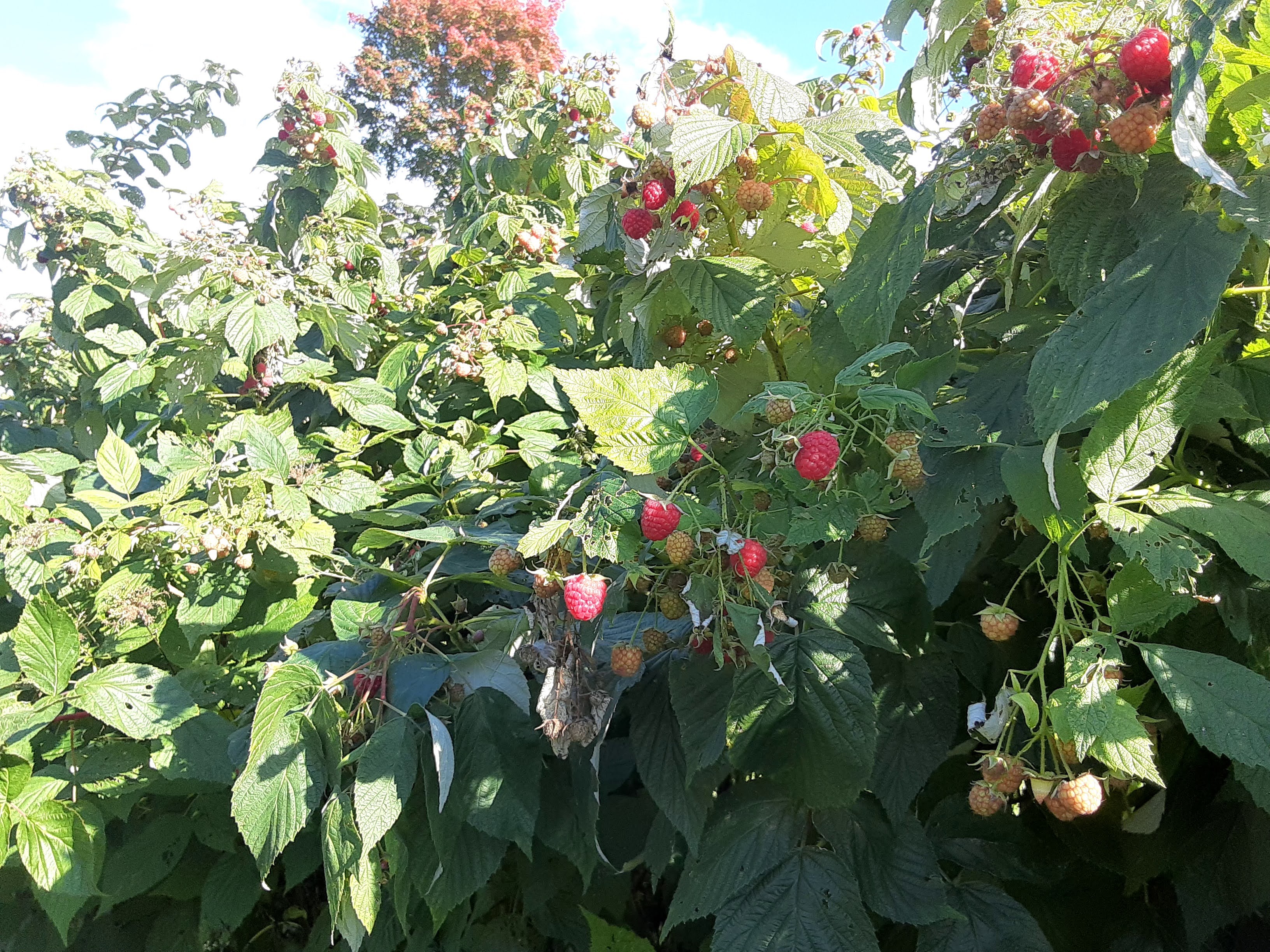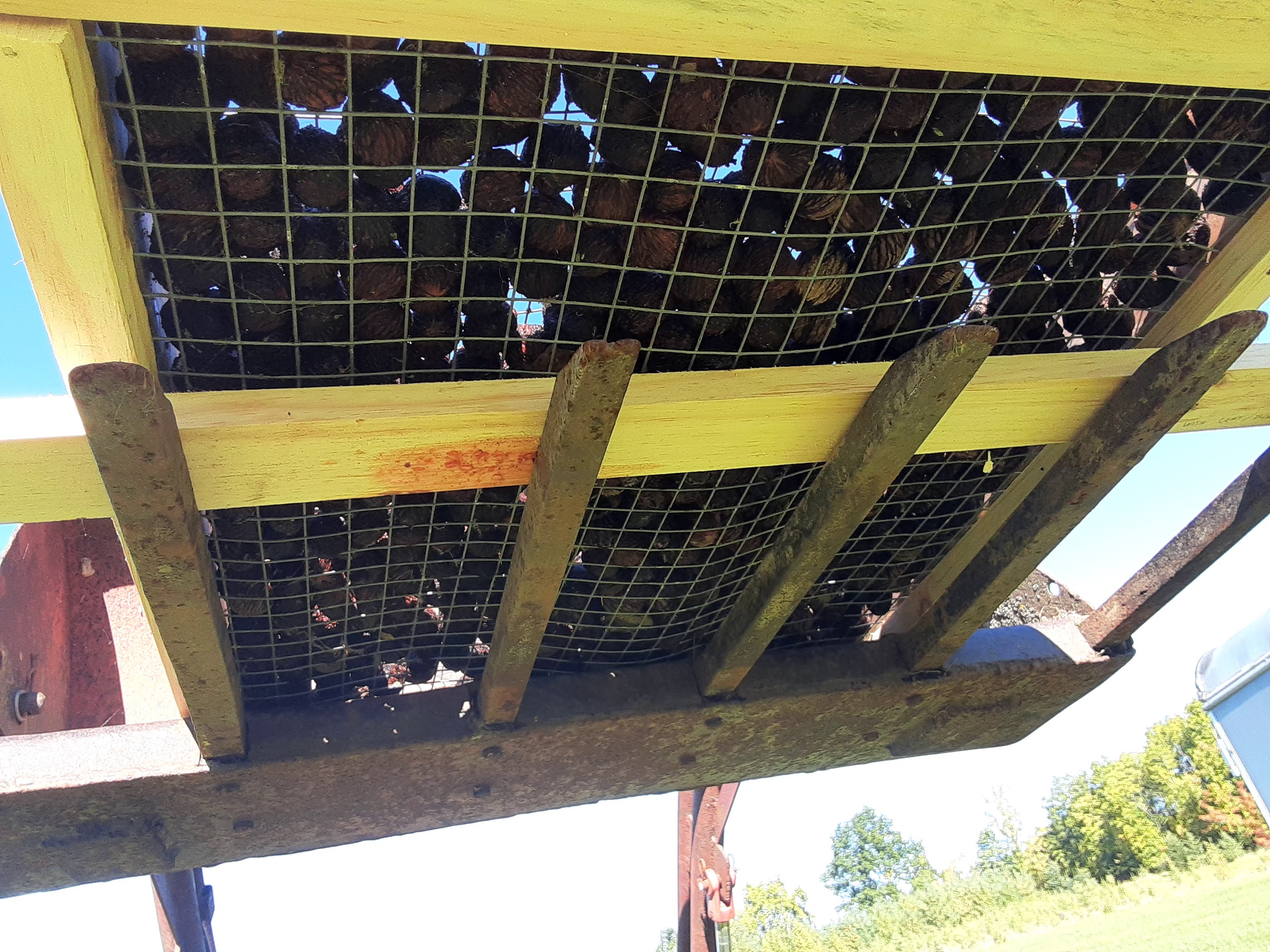Fall Raspberries and Black Walnuts
October 2, 2022
This afternoon I reluctantly took a large plastic bowl off the counter, put on my boots, hat and vest, and headed for the berry patch. This chore has been ongoing since September 2nd, a full month.
It was a beautiful, cold fall day. The loaded raspberry bushes bounced merrily around in the unaccustomed east wind, but I persevered, scooping handfuls of them into the broad, light container. The patch is a 3′ wide row, 50′ long. That’s a lot of picking, it turns out, especially late in the season when the bushes maximize their production until the frost kills them and you mow them down. Then they grow anew in the spring, only to begin the cycle again on the first of September.
The best thing about cold weather berry picking is that the insects are largely absent, (except for lady bugs today). Another tasty thing is that over-ripe berries don’t ferment the way they do in summer. Instead they turn a dark red and wait for the picker to devour their sweetness as his reward. It was a tasty afternoon, with 3 3/4 pounds of raspberries for the freezer, left over from my feast.

That’s a maple in fall colours in the background, btw.
I have written regularly in this space about my ongoing battles with red squirrels, and how I take a measure of revenge by raiding their nut caches. This year the devious little fellows relocated the cache I had such fun raiding last year. It is now 250 yards south of the other one, and somewhat better concealed. In fact, I blundered onto it by accident while trying to figure out if all of the walnut trees in the woodlot had taken the year off from nut production. In any case, I picked up six, five-gallon pails of nuts because it looked to be slim pickings this year. Even the every-year bearer at the house seems low on nuts because the neighbouring trees are barren, there are no nuts in my two, four acre nut orchards, and the five acre pine/walnut field has only one producing tree.
There must have been a late frost which caught them. Even temperatures a couple of degrees above freezing will kill the flowers. The tree at the house is protected from frost on a still night by the chimney of the furnace. Two regular-bearers back the lane are very old and tall. Their upper branches seem to miss low-lying fogs.
So in their turn I dumped four pails of nuts into my cement mixer, with streams of water and a few round stones. I borrowed my neighbour’s drying tray and prepared the extra piece of mesh to cover the nuts. In went the nuts. On went the mesh. Then I loaded the package onto the bucket of an old tractor, drove it out into an open field, and raised the loader up above my head.
The squirrels are still worried about red tails and harriers, not to mention the odd fox and coyote, all of which love a squirrel dinner. The nuts should dry in peace.

For the Love of Black Walnuts
December 10, 2021
In November our woodlot underwent an audit to requalify for the FSC rating. Glen Prevost at that time suggested that I contact the Ontario Woodlot Association. They asked me to do a film about the managed woodlot over the years. My son Charlie ran the cameras and I talked. The film dropped on December 3rd, though it is still hard to find in You-Tube’s archives.
Here is a link:
The film finally dropped on YouTube on December 12, and since then has accrued 500 views.
Local foods VS Costco
March 7, 2010
The problem with the whole local foods movement is that when it comes right down to it, consumers are slaves to their training: they resolutely search out the lowest possible price, and the kind of food everyone admits is good for you costs 30 to 40% more, so most people talk one way and then load up their carts at Costco with factory-grown chicken, pork, and imported fruits and vegetables.
This kills the market for local food. Of course it’s hard to feel enthusiastic about a cartload of Costco.
Then there’s the look on the faces of visitors to the sugar shack when they get their first taste of Canada tea, made with boiling sap and a tea bag. First it’s amazement at a new taste they haven’t encountered before. Then they look a bit bewildered: “Why am I so surprised by a new taste? Why does everything in my life taste the same? And this came from a tree?” Off they go to the woods to gather more sap.
Then there’s Christopher and his discovery of black walnuts. This pint-sized hockey player found that if he put his back into it, he could make the walnut press generate the 700 lb. of force it takes to crack the shells and give him access to delicious meats inside. He cracked a lot of nuts once he got the hang of it.
Roz and her friends have often told me that Kingston has a great deal to offer to those who live there, but the one big gap is the lack of a great, wooded park in which to wander. Christopher’s mom came back from gathering sap and enthused: “This is way better than walking around the trails in the Cataraqui Conservation Authority.”
It seems people think differently about prices when they are engaged in acts of tourism. Perhaps it’s because the thought process is longer with a vacation: tourists aspire and dream; they travel; they drink in the experience; they remember it and use it to shape their other experiences and world view. That’s much different from the immediate choice to buy pork chops or the frozen lamb at Costco.
The challenge for local food producers is to take their customers clean away from the cutthroat thought patterns of the supermarket shopper. They need make their products part of an enjoyable and memorable vacation experience to which their customers will want to return, with the price of the food a minor factor.
If individuals become tourists to explore and search for sensations lost through the commodification of modern life, why shouldn’t they find a fresh reality in the countryside? Why shouldn’t they discover the joy of fresh-picked corn, or spend a lazy afternoon under a mulberry tree, eating their fill of the strange, refreshing fruit?
How about a day picking grapes or planting trees, if extreme vacations are your thing?
My son tells me that there are no distances in air travel. The only directions are up, down, and hot.
Tourism involves a journey, but if there are no longer real distances, why can’t the journey be twenty or forty minutes to a vacation destination, instead of across the continent? Why couldn’t a garden plot provide a perfectly valid “other place” to which one’s soul can yearn to escape? Families travel to give their kids experience and understanding of their world, yet how many suburban children have ever milked a cow, planted potatoes, picked raspberries or gathered eggs? No parents would want to deny these experiences to their kids if the facilities were within easy reach.
How many of you remember biting into a fresh carrot which exploded its sweetness on the tongue? I tried a store-bought carrot a week ago and almost cried from disappointment. It was orange. That’s the best thing I can say for it.
40% more for the real thing? Sounds like a bargain — if I have stood in the garden from which it came.